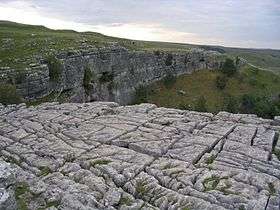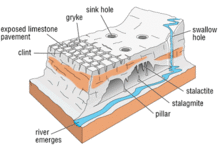Limestone pavement


A limestone pavement is a natural karst landform consisting of a flat, incised surface of exposed limestone that resembles an artificial pavement.[1] The term is mainly used in the UK where many of these landforms have developed distinctive surface patterning resembling paving blocks.[2] Similar landforms in other parts of the world are known as alvars.
Formation of a limestone pavement
Conditions for limestone pavements are created when an advancing glacier scrapes away overburden and exposes horizontally bedded limestone, with subsequent glacial retreat leaving behind a flat, bare surface. Limestone is slightly soluble in water and especially in acid rain, so corrosive drainage along joints and cracks in the limestone can produce slabs called clints isolated by deep fissures called grikes or grykes[2] (terms derived from a northern English dialect). If the grykes are fairly straight and the clints are uniform in size, the resemblance to man-made paving stones is striking, but often they are less regular. Limestone pavements that develop beneath a mantle of topsoil usually exhibit more rounded forms.
Notable examples
Limestone pavements can be found in many previously-glaciated limestone environments around the world. Notable examples are found in the Yorkshire Dales and Cumbria in Northern England, such as those above Malham Cove, on the side of Ingleborough, and above Grange-over-Sands.[3] They are also found in the Stora Alvaret in Öland, Sweden; in the Burren, County Clare, Ireland and in the Désert de Platé,[4] in the French Alps.
See also
External links
BBC Bitesize geography resource
References
- ↑ Introduction - Limestone Pavement Conservation Retrieved on 2008-06-29
- 1 2 Anon. "Geology and geomorphology". Limestone Pavement Conservation. UK and Ireland Biodiversity Action Plan Steering Group. Retrieved 30 May 2011.
- ↑ Anon. "Where to visit a limestone pavement". UK and Ireland Biodiversity Action Plan Steering Group. Retrieved 10 December 2015.
- ↑ Geology - Refuge de Platé Retrieved on 2010-08-09